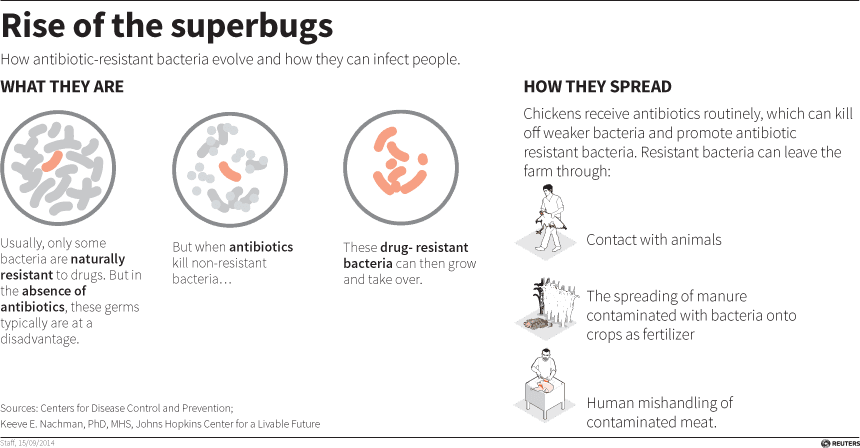Colonies of lab-grown E. coli bacteria similar to a strain carrying a gene that makes it resistant to all known antibiotics. Many bacterial pathogens are developing drug resistance due to the widespread misuse of antibiotics.
If it sometimes seems like the idea of antibiotic resistance, though unsettling, is more theoretical than real, please read on.
Listen to the interview with reporter Helen Branswell
Public health officials from Nevada are reporting on a case of a woman who died in Reno in September from an incurable infection. Testing showed the superbug that had spread throughout her system could fend off 26 different antibiotics.
“It was tested against everything that’s available in the United States … and was not effective,” said Dr. Alexander Kallen, a medical officer in the Centers for Disease Control and Prevention’s division of health care quality promotion.
Although this isn’t the first time someone in the US has been infected with pan-resistant bacteria, at this point, it is not common. It is, however, alarming.
“I think this is the harbinger of future badness to come,” said Dr. James Johnson, a professor of infectious diseases medicine at the University of Minnesota and a specialist at the Minnesota VA Medical Center.
Other scientists are saying this case is yet another sign that researchers and governments need to take antibiotic resistance seriously. It was reported Thursday in Morbidity and Mortality Weekly Report, a journal published by the CDC.
The authors of the report note this case underscores the need for hospitals to ask incoming patients about foreign travel and also about whether they had recently been hospitalized elsewhere.

The case involved a woman who had spent considerable time in India, where multi-drug-resistant bacteria are more common than they are in the US. She had broken her right femur — the big bone in the thigh — while in India a couple of years back. She later developed a bone infection in her femur and her hip and was hospitalized a number of times in India in the two years that followed. Her last admission to a hospital in India was in June of last year.
The unnamed woman — described as a resident of Washoe County who was in her 70s — went into hospital in Reno for care in mid-August, where it was discovered she was infected with what is called a CRE — carbapenem-resistant enterobacteriaceae. That’s a general name to describe bacteria that commonly live in the gut that have developed resistance to the class of antibiotics called carbapenems — an important last-line of defense used when other antibiotics fail. CDC Director Dr. Tom Frieden has called CREs “nightmare bacteria” because of the danger they pose for spreading antibiotic resistance.
In the woman’s case, the specific bacteria attacking her was called Klebsiella pneumoniae, a bug that often causes of urinary tract infections.
Testing at the hospital showed resistance to 14 drugs — all the drug options the hospital had, said Lei Chen, a senior epidemiologist with Washoe County Health District and an author of the report. “It was my first time to see a [resistance] pattern in our area,” she said.
A sample was sent to the CDC in Atlanta for further testing, which revealed that nothing available to US doctors would have cured this infection. Kallen admitted people in this field experience a sinking feeling when they’re faced with a superbug like this one.
“I think it’s concerning. We have relied for so long on just newer and newer antibiotics. But obviously the bugs can often [develop resistance] faster than we can make new ones,” he said.

Doctors and scientists who track the spread of antibiotic resistance — the rapidly proliferating swarm superbugs — see this case as a big red flag.
“If we’re waiting for some sort of major signal that we need to attack this internationally, we need an aggressive program, both domestically and internationally to attack this problem, here’s one more signal that we need to do that,” said Lance Price, who heads the Antibiotic Resistance Action Center at George Washington University.
There is international recognition of the threat, which an expert report published last year warned could kill 10 million a year by 2050 if left unchecked. In September, the UN General Assembly held a high-level meeting on antibiotic resistance, only the fourth time the body had addressed a health issue.
The woman in Nevada was cared for in isolation; the staff who treated her used infection control precautions to prevent spread of the superbug in the hospital. Chen and Randall Todd, a health department colleague, told STAT testing was done to look for additional infections, but so far none have been detected.
Johnson said it’s likely, though, that other people in the US are carrying similar bacteria in their guts and could become sick at some point. “It’s possible that this is the only person in the US and she had the bad luck to go to India, pick up the bad bug, come back and here it is, we found her and now that she’s dead, it’s gone from the US. That is highly improbable,” he said.
“People have asked me many times ‘How scared should we be?’ … ‘How close are we to the edge of the cliff?’ And I tell them: We’re already falling off the cliff,” Johnson said. “It’s happening. It’s just happening — so far — on a relatively small scale and mostly far away from us. People that we don’t see … so it doesn’t have the same emotional impact.’’
Reprinted with permission from STAT, a Boston-based news site covering health & medicine.
Related:
China Hog Farms Pose Major Health Risk
A WHO report warns we're moving toward a world where antibiotics don't work
Consumers are demanding antibiotic-free meat, and Big Food is starting to listen
